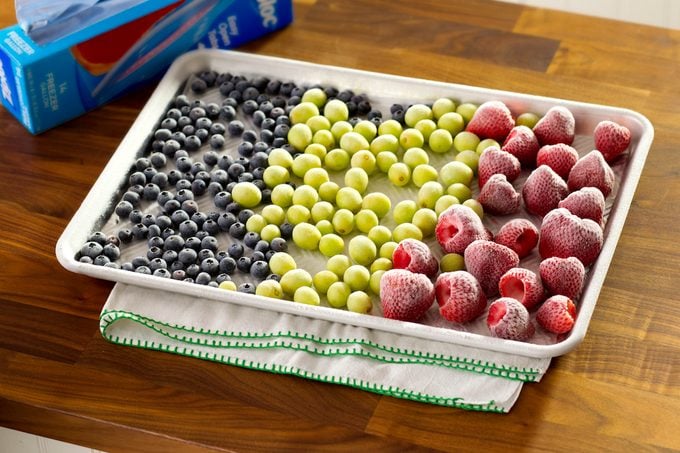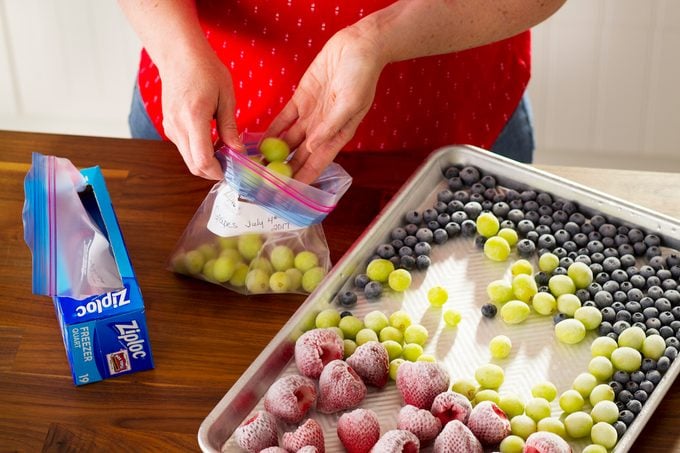How to Freeze Vegetables and Fruits
Updated: Nov. 21, 2022
Can you freeze raw vegetables and fruits? Many veggies keep better if you blanch them first, while most fruits can be frozen raw.
Whether you loaded up on berries at the farmers market or your dinner plans changed and you’re left with extra vegetables, freezing food can extend its shelf life. Here’s how to freeze vegetables and fruits so you can enjoy fresh produce even in the middle of winter.
Can You Freeze Raw Vegetables?
Except for onions and peppers, which you can freeze raw, you should blanch or fully cook vegetables before freezing. Blanching vegetables, or dunking them into boiling water, stops the enzymes that cause discoloration and turn frozen produce mushy. Raw fruit, on the other hand, freezes just fine.
You can freeze just about any vegetable except celery, watercress, endive, lettuce, cabbage, cucumber and radishes. These foods have a high water content and become soggy and water-logged when thawed.
How to Freeze Vegetables and Fruits
Although there are slight variations for different types of fruits and vegetables, follow these general steps to freeze produce.
Step 1: Wash and chop

Start by washing your produce and patting it dry with a clean towel. If you wish, you can chop vegetables or core and slice larger fruits to make them easier to use when they’re thawed.
Step 2: Freeze in a single layer

Briefly blanch vegetables to set their color and texture before cooling them down in an ice bath. Make sure to transfer your veggies to an ice bath immediately to stop the cooking process.
Then, line a baking sheet with parchment paper and freeze your produce in a single layer to prevent it from freezing together in a giant clump.
Step 3: Store in a freezer bag

Once the fruits and vegetables are fully frozen, pop them into a freezer bag, labeling and dating each one before stacking them neatly in the freezer. To prevent freezer burn, make sure each bag is airtight.
How long will your produce last in the freezer? Citrus fruit is only good for about 3 months, but according to the National Center for Home Food Preservation, all other fruits and vegetables will last 8 to 12 months.
Editor’s tip: To extend the life of your frozen produce, we recommend picking up a vacuum sealer to keep your veggies tasting moist and fresh.
How to Freeze Vegetables
Here’s how to freeze every type of vegetable so you can whip up healthy meals in a pinch.
Bell peppers: Unlike other vegetables, you don’t have to blanch bell peppers before freezing. Just remove the seeds, cut them into slices or dices, and freeze them flat in a freezer-safe bag.
Broccoli and cauliflower: Trim off any leaves and remove the stems. Cut into 1-1/2 inch pieces before blanching for 3 minutes. Then, cool in an ice bath and freeze flat on a baking sheet. (Here’s how to freeze broccoli, step by step.)
Butternut squash and other types of winter squash: Uncooked winter squash tastes very unpalatable and chalky when it’s frozen raw. Chop and cook winter squash in the oven or pressure cooker and allow it to cool before freezing.
Corn: The easiest way to freeze corn is off the cob, although you can freeze it whole if you wish. Select the freshest corn and remove the ears and silk. Blanch the cob for 4 minutes and let it cool before removing the kernels with a sharp knife. (Check out our guide to how to freeze corn three different ways.)
Green beans and peas: Remove peas from their pods and blanch for 1-1/2 minutes. For green beans (like snap or wax beans), blanch for 3 minutes.
Potatoes: Potatoes have a high water content, even when they’re cooked. We recommend only freezing waxy potatoes, like red potatoes or Yukon golds. Before freezing, chop and parcook the potatoes for 5 minutes, either by boiling them, baking them in a 475°F oven or frying them in oil at 350°F.
Zucchini and summer squash: For use in baking, blanch grated zucchini for 1 to 2 minutes, until translucent. For all other uses, cut zucchini into slices or dices and blanch for 3 to 4 minutes, until firm.
How to Freeze Fruits
Frozen fruit is perfect for making smoothies, jams and baked goods. Here’s how to freeze every type of fresh fruit, from berries to citrus.
Apples: You can freeze whole, unpeeled apples, but sliced apples keep better. To prevent browning, steam the apples for 1-1/2 to 2 minutes, or dissolve 1/2 teaspoon of ascorbic acid in 3 tablespoons water and sprinkle the mixture over the raw slices before freezing.
Bananas: Freeze whole, ripe bananas for banana bread or another baking recipe. Or, slice bananas and freeze them flat on a baking sheet for use in smoothies. (Here’s our full guide to how to freeze bananas.)
Berries: Small berries (like blueberries, blackberries and raspberries) can be frozen whole, or you can slice larger berries like strawberries. If you’re feeling adventurous, try your hand at making strawberry freezer jam.
Citrus: If you’re freezing citrus for juicing, leave the peels intact and cut the fruit in half before freezing. You can also remove the peels, cut the fruit into sections and freeze the slices. Before peeling, zest the rind—citrus zest freezes exceptionally well in freezer-safe bags.
Stone fruit, like cherries, peaches and plums: It’s best to remove the pits before freezing stone fruit because the pits can impart a bitter flavor in the freezer. If you want to remove the skins, blanch the fruit for 30 seconds. Or, simply remove the pit, slice the unpeeled fruit into quarters or eighths, and freeze flat on a baking sheet.
Tomatoes: Thawed tomato skins are very tough, so we recommend removing the skins before freezing tomatoes. Cut an “x” into the top of a tomato and boil it for 30 seconds. The skins should easily peel off. Then, remove the core and freeze the tomatoes flat. You can also freeze tomato sauce for up to 3 months in freezer-safe containers.
Teddy Nykiel, Taste of Home Associate Digital Editor, contributed to this article.
